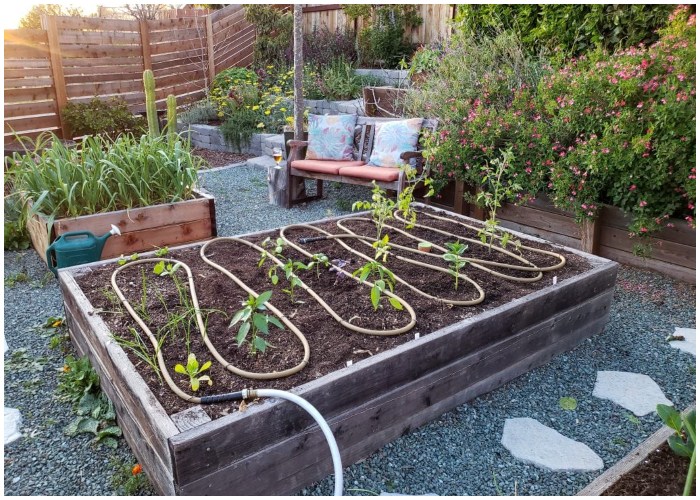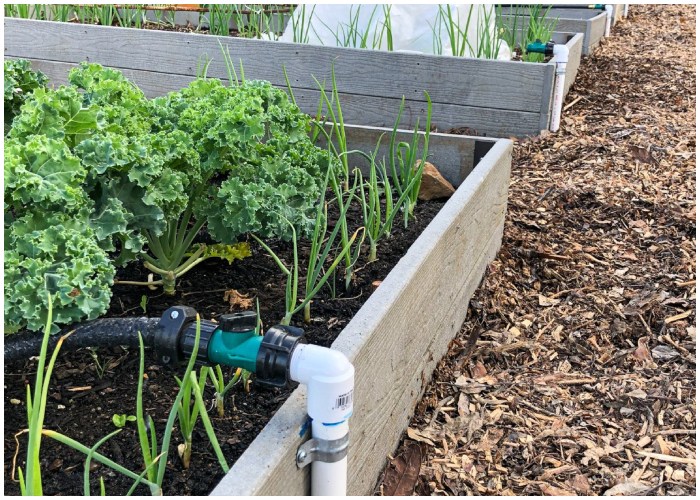Creating an irrigation system for your garden might seem daunting, but with the proper planning and materials, it’s more straightforward than you’d expect. As someone who built a DIY system that turned out to be both highly efficient and cost-effective, I’m excited to share everything I’ve learned. Whether you’re a seasoned gardener or just starting, this guide will help you set up an effective irrigation system without breaking the bank.
Why DIY Irrigation?
I wanted an affordable, easy-to-build, low-maintenance system while ensuring my garden thrived through all seasons. I tested my system through heat waves during one of the wettest decades. It performed flawlessly, proving that a DIY solution can be practical and durable.

Step 1: Choosing the Right Timer
The heart of any irrigation system is the timer. After extensive research, I found that the Orbit Watermaster yard watering system is the best choice for DIY gardeners. Priced at around $100, it transforms your standard hose faucet into a 4-station sprinkler system, with each station having independent controls. The simplicity of its setup and intuitive programming made it an easy choice for my system.
You can expand this system by adding more valves or a second timer for additional zones. This scalability is critical for those working with a more extensive garden or needing more flexibility. It’s also highly recommended that a valve be left free for manual watering when necessary.
Why Orbit Watermaster?
- Easy to install with no digging required
- Inexpensive compared to other options
- Expandable for larger gardens
- Low maintenance and easy to disassemble for winter
Step 2: Selecting Sprinkler Heads
Choosing suitable sprinkler heads is crucial for adequate irrigation. For my system, I used Rain Bird brass impact sprinklers. These heads have a spray distance of 20 to 41 feet and can easily adjust from 20° to 360°. Their flexibility allows you to design a system that covers the garden with minimal digging. Plus, they perform well in high winds, keeping water low to the ground and avoiding unnecessary waste.
Advantages of Rain Bird Sprinklers:
- Long-lasting brass and stainless steel construction
- Powerful, long-range spray with adjustable angles
- Efficient water usage, even in wind
- They rarely clog, thanks to their significant water discharge holes
I also recommend using adjustable spray heads and hose-end sprinklers for smaller areas. These are perfect for spots that are hard to reach, such as narrow strips of lawn or isolated garden patches. With timers in place, they’re excellent for automated watering, especially when you’re away.
Step 3: Setting Up Supply Lines
I chose flexible 1″ Polyethylene (Poly) pipes for supply lines. Poly pipes are highly recommended for DIY systems because they’re easier to work with than rigid PVC, especially in cooler climates with freeze-thaw cycles. They are flexible, adjustable with hose clamps, and perform well under pressure. If you ever need to make changes, you won’t have to deal with the complications of PVC glue.
Once your pipes are connected, remember to flush out the system by turning on the water and opening valves individually. This will remove any dirt or debris that could clog your sprinklers later.
Step 4: Tips for Planning Your Irrigation Design
Planning is critical to building an efficient system. Here are some tips I’ve learned:
- Measure your property carefully: Use Google Maps or Google Earth to help map your garden and divide it into zones based on your sprinkler heads’ capacity.
- Use the perimeter of your property: It’s less destructive to install supply lines along fences or garden edges rather than digging through your lawn. This also allows sprinklers to stay hidden and makes aeration easier.
- Install auto-drains: Place inline auto-drains at the low points of your supply lines to automatically drain water when the system isn’t in use. This is especially useful in colder climates, eliminating the need for end-of-season draining.

Step 5: Calculating Water Pressure and Flow
Knowing how much water pressure and flow your system needs is essential. The average home’s water pressure is between 30 and 50 PSI, which should work well for most systems. Fill a 5-gallon bucket to measure flow and calculate how many gallons per minute (GPM) your system can handle. This will help determine how many sprinkler heads you can run per zone. I recommend keeping each zone to one impact head and spray head for standard setups to maintain optimal pressure.
The Equipment List You’ll Need
Here’s a list of the equipment and materials that worked well for my DIY system:
- Rain Bird Brass Impact Sprinkler Heads
- Orbit Watermaster Timer and Auto Drains
- 1“ Poly Tubing (300 feet) and ½“ Tubing for supply lines
- Stainless Steel Hose Clamps
- 2‘ Metal Stakes for stabilizing risers
- Gardena Long Area Sprinkler for narrow spaces
- Quick Connectors and Hose Y-Connectors
- Irrigation box for timers and valves
A Simple Yet Effective System
Building your irrigation system doesn’t need to be complex or expensive. With some planning and the right equipment, you can design a system that ensures your garden stays hydrated year-round. I’ve enjoyed the process and can’t wait to expand my system further. Stay tuned for future updates on my irrigation project, and remember: the key to success is consistent, even watering.
By following this guide, you’ll be well on your way to creating an affordable and highly efficient DIY irrigation system that saves time, money, and water.